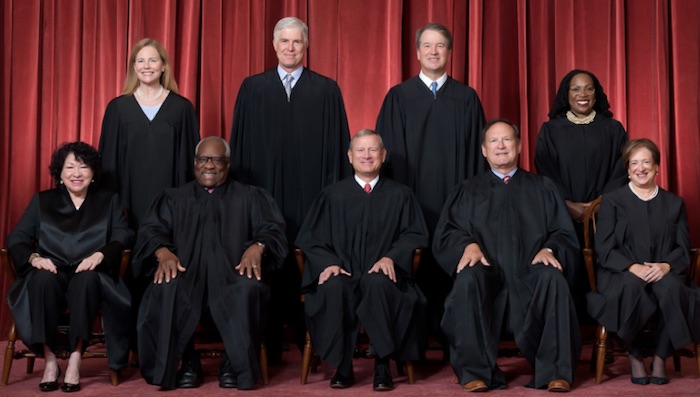
SCOTUS: Front row, left to right: Associate Justice Sonia Sotomayor, Associate Justice Clarence Thomas, Chief Justice John G. Roberts, Jr., Associate Justice Samuel A. Alito, Jr., and Associate Justice Elena Kagan. Back row, left to right: Associate Justice Amy Coney Barrett, Associate Justice Neil M. Gorsuch, Associate Justice Brett M. Kavanaugh, and Associate Justice Ketanji Brown Jackson.
The U.S. Supreme Court ruled this week that college admissions offices may not consider race in applications, and also said Americans can’t be compelled to deliver services to same-sex couples, among other decisions.
The first decision prompted a response from University of Vermont. As reported by NBC’s Stewart Ledbetter, the UVM president says that while the landmark ruling will be honored, the university’s “commitment to inclusive excellence” is not going to be changed.
It remains unclear if the university intends to openly include race as a factor in its admissions process.
NEW: @uvmvermont president re Supreme Court decision barring race in admissions:
"will affect higher education institutions of all kinds across the country. While today's decision must be carefully absorbed, at UVM our commitment to inclusive excellence will not change.' #vtpoli pic.twitter.com/qcK2v3DSVd— Stewart Ledbetter (@StewartMyNBC5) June 29, 2023
Supreme Court Chief Justice John Roberts wrote 40 pages in defense of his position. The essence of his reasoning seems largely based on the notion that no person should be judged for the color of their skin.
“Proposed by Congress and ratified by the States in the wake of the Civil War, the Fourteenth Amendment provides that no State shall ‘deny to any person … the equal protection of the laws.’ Proponents of the Equal Protection Clause described its ‘foundation[al] principle’ as ‘not permit[ting] any distinctions of law based on race or color.'”
SCOTUS rules on services for same-sex couples
Another ruling pertains to the First Amendment and whether a business must serve a same-sex couple even when its representatives disagree with same-sex marriage.
The case involved a web designer in Colorado who argued that her First Amendment right to refuse services for a same-sex couple supersedes a state law that prohibits discrimination against same-sex couples.
The 6-3 majority court opinion was written by Justice Neil Gorsuch. The New York Times noted that his decision mentions the word “compel” to express his concerns that no one should ever be forced to believe in something that they do not agree with.
“The opportunity to think for ourselves and to express those thoughts freely is among our most cherished liberties,” Gorsuch wrote. “The First Amendment envisions the United States as a rich and complex place where all persons are free to think and speak as they wish, not as the government demands.”
This decision came early on Friday, prompting some Twitter users to seek a response from Vermont’s congressional delegation.
The radical right has won, at least temporarily, not through the ballot box but rather through a corrupt #SCOTUS made possible by the anti-democratic #ElectoralCollege.#Vermont reps @SenSanders @PeterWelch @RepBeccaB any response?https://t.co/41j4PskuPX
— Gary Scudder (@scuddertravel) June 30, 2023
More cases
The nation’s highest court also put an end to the Biden administration policy that student debts can be forgiven by administrative action. The majority decision cites a liberal icon, former House Speaker Nancy Pelosi.
In writing the explanation for the majority decision, Chief Justice John Roberts wrote, “As then-Speaker of the House Nancy Pelosi explained: ‘People think that the President of the United States has the power for debt forgiveness. He does not. He can postpone. He can delay. But he does not have that power. That has to be an act of Congress.'”
Michael Bielawski is a reporter for True North. Send him news tips at bielawski82@yahoo.com and follow him on Twitter @TrueNorthMikeB.


